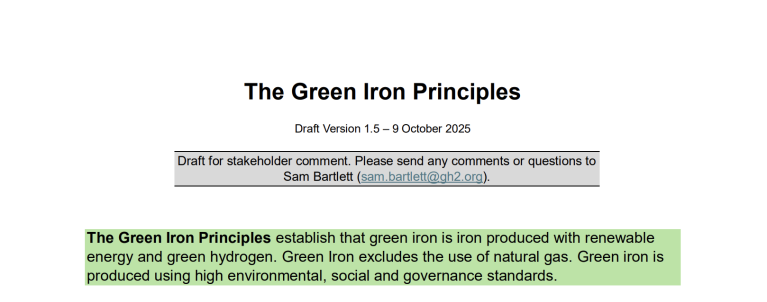The Green Iron Principles

GH2 is leading the development of the Green Iron Principles — defining green iron as iron produced with renewable energy and green hydrogen, excluding natural gas and anchored in strong environmental, social, and governance (ESG) standards.
Download the latest draft of the Green Iron Principles here.
We invite stakeholders to send comments on the draft by COB Friday 31 October 2025.
Please send your comments to Sam Bartlett at sam.bartlett@gh2.org.
Consultations
To shape and refine these principles, GH2 is hosting a consultation call with stakeholders on Wednesday, 15 October (08:00–09:00 CEST). The discussion will explore how to strengthen the principles, align them with related initiatives, and support policy and project development ahead of the planned launch of the first version at COP30 in Belém. If you would like to join the call, please get in touch via sam.bartlett@gh2.org.
Background
Steelmaking is one of the world’s most carbon-intensive industries, responsible for around 7–9% of global emissions. As the world races to decarbonise, “green iron” — iron made using renewable energy and green hydrogen — has emerged as a key pathway to clean steel. Yet despite growing investment and innovation, there is still no common definition of what truly counts as “green”.
Without clear standards, it’s difficult for policymakers, investors, and consumers to distinguish between genuinely low-carbon iron and products that only partially reduce emissions. A shared definition is essential to build credible markets, guide investment, and accelerate industrial transformation.
What are the Principles?
The goal of the Green Iron Principles is to establish a credible global definition and framework to support policy, certification, and investment in low-carbon iron production.
We build on previous work by the World Steel Association, the International Organization for Standardization (ISO), the International Energy Agency (IEA), the World Trade Organization (WTO), and the Rocky Mountain Institute (RMI). The principles also complement the work being undertaken by the First Movers Coalition, the Low Emission Steel Standard, ResponsibleSteel, SteelZero and others.
The Five Principles
1. Renewable Energy & Emissions Accounting
-
Green iron must be produced using renewable electricity and green hydrogen, with emissions aligned to national climate goals (NDCs).
-
Emissions are calculated using ISO/DIS 20915 life cycle standards.
-
Data must be site- and product-specific, auditable, and cover “mine to delivery gate” emissions.
2. Green Hydrogen Only
-
Hydrogen used in production must be made via electrolysis powered by 100% (or near 100%) renewable energy, consistent with the Green Hydrogen Standard 2.0, achieving near-zero greenhouse gas emissions.
3. Exclusion of Natural Gas
-
Natural gas is excluded from green iron production, except in limited backup or feedstock roles.
-
Any gas use must be transparently reported using verified, site-specific emissions data.
4. Renewable Electricity Integrity
-
Electricity must come from verified renewable sources such as solar, wind, hydro, geothermal, or ocean energy.
-
Projects must demonstrate low land-use and biodiversity risks if biomass is used.
-
Grid-connected projects must ensure credible renewable sourcing via Power Purchase Agreements (PPAs) or certified renewable energy certificates (RECs/EACs).
-
Electricity use should align with best practice on additionality, time matching, and deliverability per the Greenhouse Gas Protocol.
5. ESG and Sustainability Standards
-
Green iron projects must uphold high ESG performance, assessing:
-
Social and environmental impacts,
-
Stakeholder engagement and community benefits,
-
Health, safety, and governance.
-
The ResponsibleSteel International Production Standard V2.1.1 provides a baseline, complemented by the Green Hydrogen Standard for responsible sourcing of inputs.